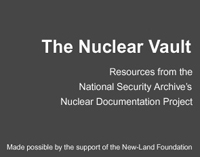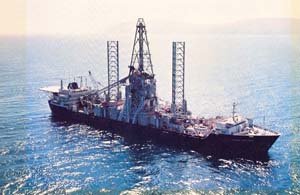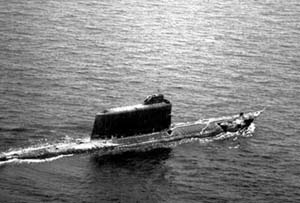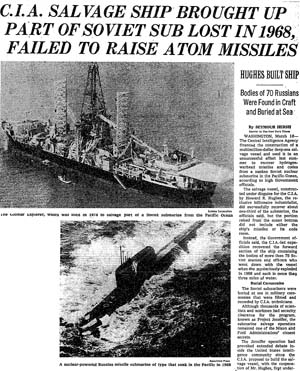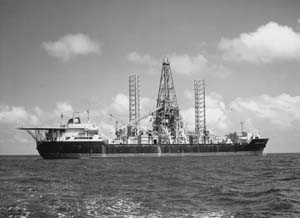home | about | documents | news | publications | FOIA | research | employment | search | donate | mailing list
Project Azorian
The CIA's Declassified History of the Glomar Explorer
Posted - February 12, 2010
Edited by Matthew Aid with William Burr and Thomas Blanton
For more information contact: 202/994-7000
|
||
|
||
|
||
|
||
|
Washington, D.C., February 12, 2010 - For the first time, the Central Intelligence Agency (CIA) has declassified substantive information on one of its most secret and sensitive schemes, "Project Azorian," the Agency codename for its ambitious plan to raise a sunken Soviet submarine from the floor of the Pacific Ocean in order to retrieve its secrets. Today the National Security Archive publishes "Project Azorian: The Story of the Hughes Glomar Explorer," a 50-page article from the fall 1985 edition of the Agency's in-house journal Studies in Intelligence. Written by a participant in the operation whose identity remains classified, the article discusses the conception and planning of the retrieval effort and the creation of a special ship, the Glomar Explorer, which raised portions of the submarine in August 1974. The National Security Archive had submitted a Freedom of Information Act (FOIA) request to the CIA for the document on December 12, 2007.
National Security Archive director Tom Blanton commented that "the Navy alternative to the Glomar Explorer--investigation by a deep sea submersible--sounds more convincing than the claim in the Studies in Intelligence article that Project Azorian advanced the cutting edge of deep sea exploration the way the CIA did on aerial and satellite reconnaissance. To me, Glomar resembles the Bay of Pigs more than U-2 or Corona. On the latter, they brought in the best people, Ed Land and the Skunk Works, on the former, they only talked to themselves."
Also published today for the first time are recently declassified White House memoranda of conversations from 1975 which recount the reactions of President Ford and cabinet members to ongoing news of press leaks about the Glomar Explorer, including Seymour Hersh's exposé in The New York Times on March 19, 1975.
Project Azorian
The CIA's Declassified History of the Glomar Explorer
By Matthew Aid
For the first time, the Central Intelligence Agency (CIA) has declassified substantive information on one of its most secret and sensitive schemes, "Project Azorian," the Agency codename for its ambitious plan to raise a sunken Soviet submarine from the floor of the Pacific Ocean in order to retrieve its secrets. Today the National Security Archive publishes "Project Azorian: The Story of the Hughes Glomar Explorer," a "Secret" 50-page article from the fall 1985 edition of the Agency's in-house journal Studies in Intelligence. Written by a participant in the operation whose identity remains classified, the article discusses the conception and planning of the retrieval effort and the creation of a special ship Glomar Explorer, which raised portions of the submarine in August 1974. The National Security Archive submitted a Freedom of Information Act (FOIA) request to the CIA for the document on December 12, 2007.
Also published today for the first time are recently-declassified White House memoranda of conversations from 1975 recounting the reactions of President Ford and cabinet members to ongoing news of press leaks about the Glomar Explorer, including Seymour Hersh's exposé in The New York Times on March 19, 1975.
The first sketchy details of the program were published by the Los Angeles Times in February 1975 and by columnist Jack Anderson in a March 18 radio program, and were further developed in Hersh's March 19 article in the New York Times. Since then the CIA has been so adamant in its refusal to declassify any material related to "Project Azorian" that it will neither confirm nor deny that the operation ever existed. This doctrine changed slightly in the 1990s, when the Agency declassified a videotape given previously to Russian president Boris Yeltsin showing the burial at sea of the Russian crewmen who were found in the portion of the submarine that the CIA raised to the surface. But other than this videotape, for the past 35 years the public has had to rely for everything that it knew about the project on a very small number of books and articles written without access to the classified records. (Note 1)
This newly-released CIA document vastly expands what we know about this poorly-understood operation. Despite significant redactions made by the CIA, the article contains a detailed chronological history of the program from its inception until Jack Anderson published the first hard details about the program in April 1975. Internal evidence suggests that the article was written in 1978, but it was prepared at such a high level of classification that it was apparently unpublishable until the Agency made decisions in 1985 to downgrade it to "Secret."
The story of "Project Azorian" began on March 1, 1968, when a Soviet Golf-II submarine, the K-129 (the CIA history refers to the submarine by its pendant number - 722), carrying three SS-N-4 Sark nuclear-armed ballistic missiles, sailed from the naval base at Petropavlovsk on the Kamchatka Peninsula to take up its peacetime patrol station northeast of Hawaii. If war had broken out, the K-129 would have launched its three ballistic missiles, each carrying a one megaton nuclear warhead, at targets along the west coast of the United States. But something went terribly wrong, for in mid-March 1968 the submarine suffered a catastrophic accident and sank 1,560 miles northwest of Hawaii with the loss of its entire crew. Interestingly, the CIA history is silent on the cause of the accident, mentioning neither how the agency came to learn of the sub's demise nor the exact location of its resting place 16,500 feet below the surface of Pacific. It is quite likely that this information was Top Secret, and could not be included in the article at the Secret classification level, despite the fact that books and articles about the project back in the 1970s mention that the U.S. Navy's SOSUS underwater sonar system detected the location of the sunken submarine.
The article traces in detail the trials and tribulations of "Project Azorian" over the next six years, culminating on August 8, 1974, when the commercial vessel specially modified to perform the secret mission, the Hughes Glomar Explorer, raised a portion of the K-129 to the surface and took it to Hawaii for detailed examination.
The declassified article is replete with information that has never been made public before now:
- On July 1, 1969, the CIA established the Special Projects Staff within its Directorate of Science and Technology to manage "Project Azorian." The head of the unit was John Parangosky, a senior official in the CIA's Directorate of Science and Technology who had previously managed the development and operation of a number of highly-classified CIA aerial reconnaissance systems. His deputy, and the man who ran the day-to-day operations of Project Azorian for the next six years, was a U.S. Naval Academy graduate and World War II submarine officer named Ernest "Zeke" Zellmer. President Richard Nixon personally approved the creation of the special task force in August 1969. (pp. 4-5)
- With President Nixon's approval in hand, on August 19, 1969, CIA director Richard Helms placed all information concerning the work being done by Parangosky and Zellmer's staff in a special security compartment called "Jennifer," thus restricting all knowledge of what these men were doing to a very small and select group of people inside the White House and the U.S. intelligence community, including President Richard Nixon and his national security advisor, Henry Kissinger. It should be noted that in the 1970s, a number of books and articles claimed incorrectly that "Jennifer" was the name of the operation. (p. 5)
- It was not until October 1970 that a team of CIA engineers and specially-cleared contractors determined that the only technically-feasible way to lift the huge 1,750-ton Soviet submarine off the sea floor was to slip a specially-made sling made out of pipe-strings around the submarine, then slowly raise the sub to the surface using heavy-duty winches mounted on a specially-modified ship built for this purpose. (p. 9, 15)
- Initially, senior intelligence officials were not particularly optimistic about the chances of success for the operation, believing that there was only a 10 percent chance that the operation would succeed. (p. 11)
- In August 1971, during the early research and development stage of the program, "Project Azorian" came within inches of being cancelled because of huge cost overruns. According to the article, the only thing that saved the program from being terminated was the potential intelligence bonanza that would accrue if the project succeeded. Despite deep concerns about rising costs on the part of the officials overseeing "Project Azorian," on October 4, 1971 the CIA was authorized to proceed with the program. (pp. 13, 15)
- Work began immediately building a ship specifically designed to conduct the operation. On November 16, 1971, the keel was laid at the Sun Shipbuilders yard in Chester, Pennsylvania of what would become the Hughes Glomar Explorer. The initial schedule called for the ship to be launched on October 5, 1972, and delivered to the CIA on April 20, 1973. (p. 15)
- The developing U.S.-Soviet détente, symbolized by the cordial meetings between President Nixon and Soviet leader Leonid Brezhnev at the May 1972 Moscow summit, threatened to derail Azorian. In July 1972, the special Executive Committee, which oversaw the project, asked the high-level and top secret 40 Committee, which oversaw all sensitive intelligence operations, to review the project due to the possibility that, by the time it was ready for deployment in 1974, "the developing political climate might prohibit mission approval." The views of other senior government officials cleared for access to "Project Azorian" were also solicited. The response was far from positive. The Deputy Secretary of Defense, the chairman of the Joint Chiefs of Staff, the Chief of Naval Operations, the Assistant Secretary of Defense (Intelligence), and the director of the Defense Intelligence Agency (DIA) all recommended that "Project Azorian" be terminated because, in addition to the rapidly rising costs of the program and the political risks involved, the value of the anticipated intelligence gain from the operation was probably less than what the CIA believed. Despite the impressive heft of these negative assessments of "Project Azorian," on December 11, 1972, President Richard Nixon ordered that the program be continued. This proved to be the last major bureaucratic obstacle that "Project Azorian" had to clear. (pp. 16-19)
- While docked at the port of Long Beach, California between October 1973 and January 1974, 24 vans containing the classified equipment needed to perform the mission were loaded aboard the Hughes Glomar Explorer. (p. 25)
- In November 1973, a strike by union members belonging to the Marine Engineers Benevolent Association (MEBA) disrupted the completion of the fitting out of the Hughes Glomar Explorer for its mission at Long Beach. Because the mission could only be accomplished during a ten week "weather window" between July and mid-September, CIA officials were concerned that the delay could cause the ship to miss its deployment date. If that had happened, the mission would have been delayed for an entire year until the next period of favorable weather conditions occurred. (pp. 27-28)
- On June 7, 1974, President Nixon personally approved launching the "Project Azorian" mission, with the stipulation that the Hughes Glomar Explorer not begin its work until after he had returned from a summit meeting in Moscow scheduled to last from June 27, 1974, to July 3, 1974. The Glomar Explorer arrived at the recovery site 1,560 miles northwest of Hawaii on July 4, 1974, the day after Nixon left Moscow. Recovery operations commenced immediately to attach the pipe-string collars around the Soviet submarine. (pp. 36-37)
- The Hughes Glomar Explorer's recovery operations were greatly complicated by almost 14 days of near-continuous surveillance of the ship's work by two Soviet naval vessels. Despite the presence of the Soviet surveillance vessels, recovery work did not stop. But fearing that the Soviets might try to land personnel on his ship by helicopter, on July 18, 1974, the CIA mission director on the Glomar Explorer ordered crates stacked on his ship's helicopter deck to prevent the Soviets from landing on it. According to the article, orders were given to "be prepared to order emergency destruction of sensitive material which could compromise the mission if the Soviets attempted to board the ship. The team designated to defend the control room long enough to destroy the material... was alerted, but guns were not issued." (p. 39)
- The Hughes Glomar Explorer began lifting the K-129 off the sea floor on August 1, 1974, more than three weeks after the ship arrived at the recovery site. It took eight days to slowly winch the remains of the Soviet submarine into the massive hold of the Glomar Explorer, with the sub finally being secured inside the ship on August 8, 1974. The next day, recovery operations were completed and the ship sailed for Hawaii to offload its haul. (pp. 43-46)
Unfortunately, the CIA made significant deletions from the text of the article, which makes it extremely difficult to accurately gauge just how successful "Project Azorian" was. For example, the CIA refused to declassify any information concerning the massive cost overruns, which threatened to shut down the program during its early stages. Subsequent reports estimate that as much as $500 million (in 1974 dollars) were spent. Nor did the declassified portions of the CIA article answer the critically important questions of how much of the submarine the Hughes Glomar Explorer managed to bring to the surface, or what intelligence information was derived from the exploitation of the portions of the sub that were recovered. Unfortunately, this material apparently was either redacted from the text or not included because of the high classification assigned to this material.
So what can we surmise about what "Project Azorian" accomplished? Because the CIA article provides no answers to this critical question, the prevailing school of thought maintains that the project failed to accomplish its primary goals. Pulitzer Prize-winning journalist Seymour Hersh's March 1975 New York Times article reported that the mission was, in the opinion of senior U.S. Navy officials, a failure, because the CIA did not recover any of the K-129's SS-N-4 nuclear-armed ballistic missiles. Sherry Sontag and Christopher Drew's 1998 book Blind Man's Bluff reported that only a 38-foot long forward section of the K-129 was recovered, including the sub's torpedo compartment and its store of Russian nuclear torpedoes. Ninety percent of the highly-fragile submarine, including the conning tower, missile compartment, control room, radio shack and engine room, broke free and fell back to the ocean floor, disintegrating on contact. "Back to the ocean floor went the intact [SS-N-4] nuclear missile, the codebooks, decoding machines, the burst transmitters. Everything the CIA most wanted to reclaim." And because only small fragments survived the disintegration of the submarine when it hit bottom, the CIA decided not to make a second attempt to retrieve what was left. Sontag and Drew argue that a Navy proposal to use a deep-sea submersible to probe the sunken vessel was never properly vetted, although it may have produced better results. (Note 2)
There apparently were some tangential benefits that accrued from the project. In June 1993, a panel of Russian experts prepared a report for President Boris Yeltsin, using only information made available to them by the Russian intelligence services, which concluded that the CIA recovered at least two nuclear-armed torpedoes from the portion of the K-129 that it managed to bring to the surface. According to the report, the level of plutonium radiation the CIA team on the Hughes Glomar Explorer encountered was consistent with two nuclear warheads. (Note 3) This conclusion is partially confirmed in the surviving text of the CIA article, which reported that Glomar Explorer's recovery crew had to deal with plutonium contamination once the sub was raised to the surface caused by the one-point detonation of the high explosive components of one or more of the K-129's nuclear torpedoes. (p. 46)
So was "Project Azorian" a waste of time and taxpayer money? We will not know for sure until the CIA declassifies the remainder of this article and other documents relating to this operation.
|
Document 1: [Author excised], "Project Azorian: The Story of the Hughes Glomar Explorer," Studies in Intelligence, Fall 1985, Secret, Excised copy
Document 2: Memorandum of Conversation, February 7, 1975, 5:22-5:55 p.m., Confidential, Excised copy
Archival source: Gerald R. Ford Presidential Library; National Security Adviser--Memoranda of Conversation, box 9, February 7, 1975 - Ford, Kissinger, Schlesinger, Colby, General David C. Jones, Rumsfeld
Calling his national security team together, President Ford expressed his worries about leaks to the press, such as reports on recent National Security Council discussions of the SALT [Strategic Arms Limitations Talks]. During the course of the discussion, Director of Central Intelligence (DCI)William Colby interjected that he had been in touch with the Los Angeles Times, whose editors were going to publish an article about the Glomar Explorer. He said that he called Franklin D. Murphy, the chief executive officer of the Times-Mirror Company, which published the Times, but his call was to no avail. The next afternoon, February 8, 1975, it ran a story entitled "U.S. Reported After Russian Submarine/Sunken Ship Deal by CIA."
Document 3: Memorandum of Conversation, "[Jennifer?] Meeting,"March 19, 1975, 11:20 a.m., Secret, Excised copy
Archival source: Ford Library, National Security Adviser--Memoranda of Conversation, box 10, March 19, 1975 - Ford, Schlesinger, Colby, Buchen, Marsh, Rumsfeld
The day that Seymour Hersh's story appeared in The New York Times, Ford also met with top advisers. Secretary of Defense (and former Director of Central Intelligence) Schlesinger recommended acknowledging the "bare facts" because it was implausible to deny the story. DCI Colby, however, thought otherwise and his advice prevailed. Remembering that President Eisenhower's admission of the downed U-2 exacerbated the 1960 crisis, he suggested that confirming the story would put Moscow under "pressure to respond."
Notes
1. Two books have been written about the project: Clyde W. Burleson, The Jennifer Project (Englewood Cliffs, N.J.: Prentice-Hall, 1977); and Roy Varner and Wayne Collier, A Matter of Risk (New York: Random House, 1977). See also Seymour Hersh, "C.I.A. Salvage Ship Brought Up Part of Soviet Sub Lost in 1968, Failed to Raise Atom Missiles, The New York Times, March 19, 1975; "The Great Submarine Snatch," Time, March 31, 1975, pp. 20-27; Seymour Hersh, "Human Error Is Cited in '74 Glomar Failure," The New York Times, December 9, 1976, pp. 1, 55. See also the CIA's review of Clyde Burleson's book in John Milligan, "The Jennifer Project," Studies in Intelligence, Vol. 23, No. 1, Spring 1979, p. 45.
2. Sherry Sontag and Christopher Drew, Blind Man's Bluff: The Untold Story of American Submarine Espionage (New York: Public Affairs, 1998), 83-84, 180, 198.
3. Jeffrey T. Richelson, A Century of Spies: Intelligence in the Twentieth Century (NY: Oxford University Press, 1995), p. 352n, citing William J. Broad, "Russia Says U.S. Got Sub's Atom Arms," The New York Times, June 20, 1993, p. 4; "CIA Raising USSR Sub Raises Questions," FBIS-SOV-92-145, July 28, 1992, pp. 15-16.
